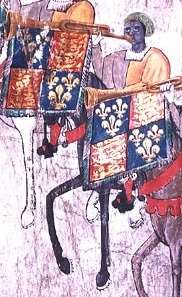John Blanke

John Blanke (also rendered Blancke or Blak) (fl. 1501–1511) was a black musician in London in the early 16th century.
He was probably brought to England as one of the African attendants of Catherine of Aragon in 1501. He is one of the earliest recorded black people in England after the Roman period[1] [2]. His name may be a reference to his skin colour, derived either from the word "black" or from the French word "blanc" meaning white.
Background
Historian Onyeka Nubia has written about John Blanke's possible origins in his 2013 book Blackamoores: Africans in Tudor England, their Presence, Status and Origins.[3] and in two articles. One is "Tudor Africans: What’s in a Name?" in October 2012 for History Today magazine[4] and the other is "The Missing Tudors. Black People in 16th Century England" for the BBC History Magazine, published in July 2012.[5]
Little is known of Blanke's life, but he was paid 8d per day by Henry VII. A surviving document from the accounts of the Treasurer of the Chamber records a payment of 20 shillings to "John Blanke the blacke trumpet" as wages for the month of November 1507, with payments of the same amount continuing monthly through the next year.[6] He successfully petitioned Henry VIII for a wage increase.[7]
Dr Sydney Anglo was the first historian to propose that the "blacke trumpet" in the 1507 court accounts was the same as the black man depicted twice in the 1511 Westminster Tournament Roll.[8] He had proposed this in a footnote to his article about The Court Festivals of Henry VII.[9] The Westminster Tournament Roll is an illuminated, 60-foot-long manuscript now held by the College of Arms; it recorded the royal procession to the lavish tournament held on 12 and 13 February 1511 to celebrate the birth of a son, Henry, Duke of Cornwall (d. 23 February 1511), to Catherine and Henry VIII on New Year's Day 1511. John Blanke is depicted twice, as one of the six trumpeters on horseback in the royal retinue. All six of the trumpeters wear yellow and grey livery, and bear a trumpet decorated with the royal arms; Blanke alone wears a brown and yellow turban, while the others are bare-headed with longish hair. He appears a second time in the roll, wearing a green and gold head covering.
Black trumpeters and drummers were documented in other Renaissance cities, including a trumpeter for the royal ship Barcha in Naples in 1470, a trumpeter recorded as galley slave of Cosimo de' Medici in 1555, and black drummers in the court of James IV in Edinburgh.
References
- ↑ David Olusoga, "Black people have had a presence in our history for centuries. Get over it", The Guardian, 13 August 2017.
- ↑ Phil Gregory, "Black Romans in Britain". The Black Presence in Britain.
- ↑ Onyeka. Blackamoores: Africans in Tudor England, their Presence, Status and Origins, London. Narrative Eye, 2013.
- ↑ Onyeka (October 2012), "Tudor Africans: What's in a Name?" History Today 62 (10).
- ↑ Onyeka, "The Missing Tudors: black people in 16th-century England", History Extra, 24 January 2014. First published in BBC History Magazine, July 2012.
- ↑ Miranda Kaufmann, "Blanke, John (fl. 1507–1512), royal trumpeter", Oxford Dictionary of National Biography.
- ↑ Michael Ohajuru, "John Blanke, Henry VIII’s Black Trumpeter, Petitions for a Back Dated Pay Increase", the many-headed monster, 27 July 2015.
- ↑ "Sydney Anglo: The Historian Who Identified John Blanke", The John Blanke Project.
- ↑ Sydney Anglo (B.A., Ph.D., Research Fellow of the University of Reading), " "The Court Festivals of Henry VII: A Study Based Upon the Account Books of John Heron, Treasurer of the Chamber", Bulletin of John Rylands Library, xliii, Volume 43, 1960–1961.
Further reading
- "John Blanke, Black Trumpeter", Black Presence: Asian and Black History in Britain, National Archives.
- "The Black Trumpeter at Henry VIII's Tournament", National Archives.
- "Pay Day for John Blanke", National Archives.
- "Black Moors in Scotland", National Archives.
- Miranda Kaufmann, "John Blanke, the Trumpeter", in Black Tudors: The Untold Story, Oneworld Publications, 2017, pp. 7–31.
- K. J. P. Lowe, Black Africans In Renaissance Europe, Cambridge University Press, 2005, ISBN 0521815827, p. 39.
- David Bindman, Henry Louis Gates, Jr., Karen C. C. Dalton, The Image of the Black in Western Art: pt. 1. From the 'age of discovery' to the age of abolition: artists of the Renaissance and Baroque, Volume 3, Part 1 of The Image of the Black in Western Art; Harvard University Press, 2010, ISBN 0674052617, p. 236.
- Imtiaz H. Habib, Black Lives in the English Archives, 1500–1677: Imprints of the Invisible, Ashgate Publishing, 2008, ISBN 0754656950, p. 39.
- "Britain's first black community in Elizabethan London", BBC News, 20 July 2012.
- Marika Sherwood, "Blacks in Tudor England", History Today, Volume: 53 Issue: 10.
- "Blanke, John (16th Century)", BlackPast.org.
- "John Blanke-A Black Trumpeter in the court of King Henry VIII", The Black Presence in Britain, 12 March 2009.